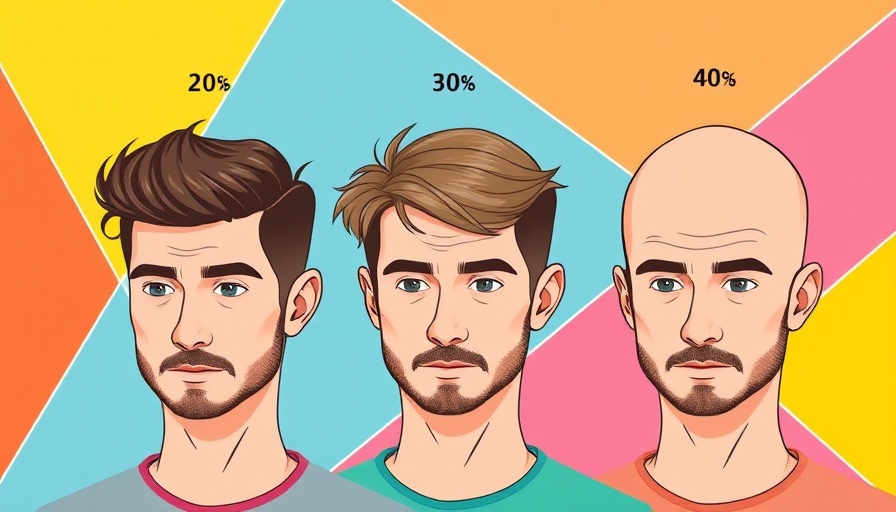
Understanding Male Pattern Baldness: An Insight into Jimmy's Journey
In a world where appearance can significantly impact personal and professional lives, the topic of hair loss often stirs up a variety of emotions. Take Jimmy, a man who seemingly has it all, from a flourishing career to a loving family. Yet, like many men, he faces the stark reality of male pattern baldness. This phenomenon is not just a cosmetic concern; it encompasses psychological, emotional, and health factors that can profoundly affect a man's quality of life.
In 'Going Bald? This Could Be Why...', the discussion dives into the complexities of male pattern baldness, exploring key insights that sparked deeper analysis on our end.
The Genetics Behind Hair Loss: A Closer Look
One of the most critical factors contributing to male pattern baldness is, as research shows, genetics. Male pattern baldness, scientifically termed androgenetic alopecia, affects nearly 50% of men by their 40s and is largely hereditary. A study revealed that a staggering 81% of male pattern hair loss cases can be attributed to genetic factors passed down from both the mother’s and father’s side. This means that if you're witnessing hair loss, it's not just a consequence of aging; it's embedded in your genetic code.
Decoding the Process of Hair Loss
What exactly happens when a man begins to lose his hair? It all boils down to the hair growth cycle, which consists of a growth phase, a resting phase, and the eventual shedding of hair. In men susceptible to androgenetic alopecia, the hair follicles become sensitive to a hormone derivative of testosterone called dihydrotestosterone (DHT). This sensitivity results in a shortened growth phase, whereby hair becomes progressively thinner and sparser. Essentially, men like Jimmy may find their locks growing ever shorter and thinner before they notice the balding pattern significantly changing.
The Myths and Realities of Balding
Through the haze of information surrounding male baldness, several myths persist. A common misconception is that men who are balding have higher testosterone levels than their non-balding peers. In actuality, studies indicate that testosterone levels remain fairly consistent across both groups; the real issue lies in the conversion rate to DHT. Additionally, the idea that libido or sexual activity influences hair loss is equally unfounded. Instead, it’s crucial to focus on factors such as genetics and hormonal sensitivity to gain a clearer understanding of hair loss.
Compounded Effects: Psychological Ramifications
Hair loss can lead to significant psychological effects. From self-consciousness to feelings of unattractiveness, the emotional toll can sometimes lead men into depressive states. A sense of vulnerability accompanies losing one's hair, which can affect daily interactions and overall mental wellness. For Jimmy, and others like him, embracing the reality of losing their hair, while emotionally turbulent, can be a necessary step toward self-acceptance and confidence.
Exploring Treatment Options: Hope on the Horizon
Fortunately, treatment options abound for those unhappy with the prospect of baldness. Many men turn to hair transplants or medications like minoxidil and finasteride to combat their thinning locks. The earlier these treatments are initiated, the better the results tend to be. As Jimmy contemplates his choices, a wave of hope unfurls—there are viable paths to mitigate hair loss that promise to enhance self-esteem and satisfaction.
Decisions Moving Forward: Embracing Change
As he weighs his options, how Jimmy feels about his perceived baldness is crucial. While some embrace a bald look for ease and simplicity, others may need more time to adjust to this change. It's essential to remember that male pattern baldness is a normal part of aging, and acceptance is often the first step toward finding peace in this stage of life.
Taking Action: What Can You Do?
The key takeaway from understanding male pattern baldness is awareness. Knowledge about its causes, preventative measures, and treatment options can empower men to make well-informed choices. Engaging in discussions—much like the one featured in Jimmy's story—helps to normalize baldness and lessen the stigma associated with it. It’s important for men to understand that they are not defined by their hair.
If you found this insight into male pattern baldness useful, consider sharing your thoughts or experiences with us. Engaging in a community dialogue can significantly help others facing similar challenges. Remember, hair or not, it is the essence of an individual that truly defines them.
 Add Row
Add Row  Add
Add 




Write A Comment